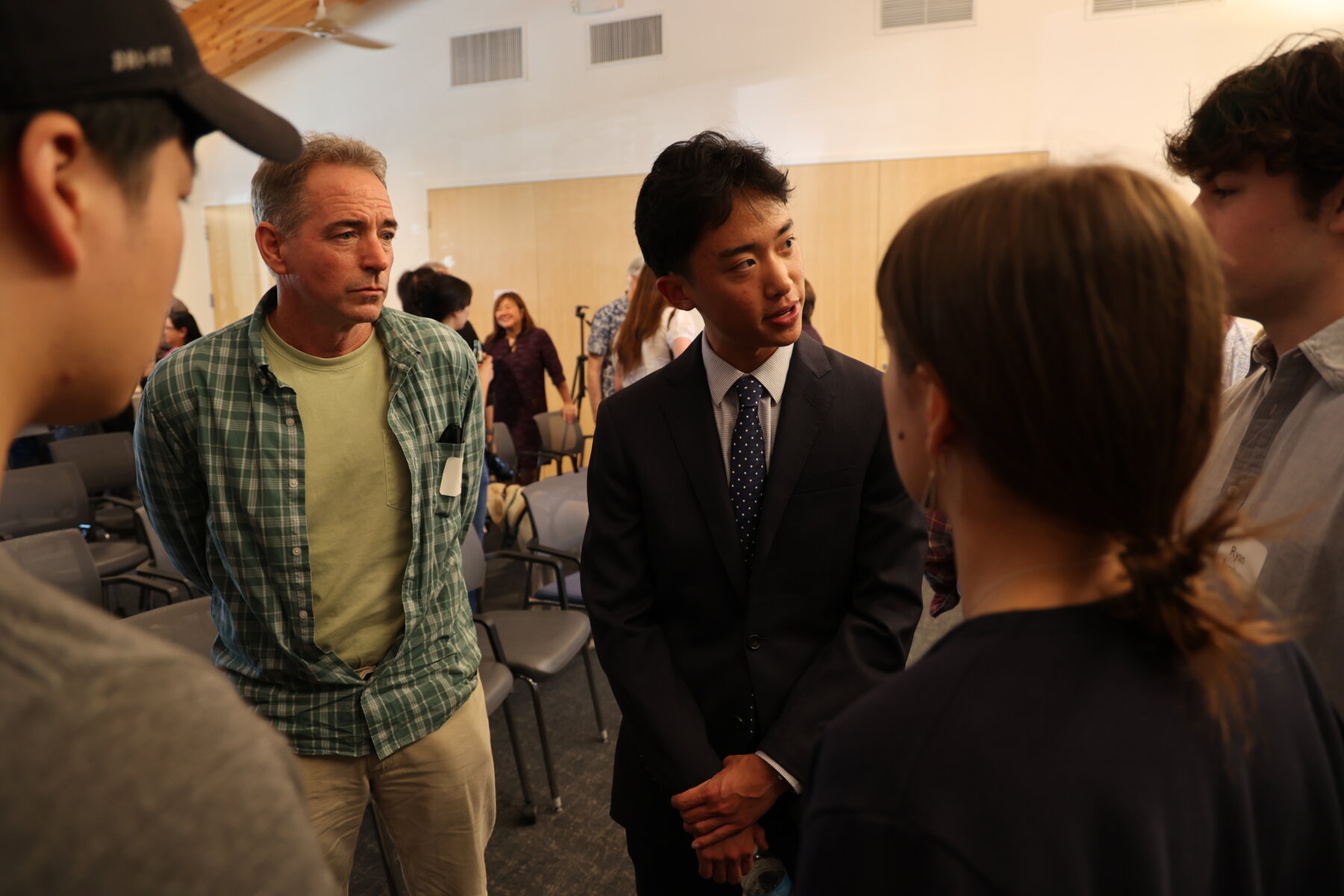
Two weeks into Tomoki Chien’s freshman year in the University of Southern California’s journalism program, he became frustrated that nonjournalism students didn’t seem to care about local news. To bridge that gap, Chien founded a newsletter called “Morning, Trojan,” which aggregated five of the top news stories at the national, state and local levels, accompanied by short summaries.
A year later, “Morning, Trojan” is one of three California college newsletters run by his nonprofit media company, College Brief. With more than 1,000 subscribers just from word of mouth, Chien plans to take his newsletter model national this year.
“The value is in how brief it is — it’s visually pleasing,” said Chien, now a sophomore. “The problem with local news is there are about 20 or 30 outlets that you need to read if you really want to understand one thing, and nobody else is printing that all in one place.”
Chien is among a growing number of young entrepreneurial journalists forging a path in nonprofit journalism, worker-owned media outlets or media collectives. In 2022, the Institute for Non-Profit News reported a 17% increase in nonprofit digital news outlets from the year before. The number of employee-owned companies in the U.S. is also steadily increasing — more than 14 million people were considered worker-owners of their companies in 2021, according to the National Center for Employee Ownership.
This growth in smaller nonprofit outlets contrasts with the recent mass layoffs at high-profile publications like the LA Times, Vox and Sports Illustrated, along with the closing of digital sites Vice, BuzzFeed News and The Messenger. As Politico recently reported, over 3,000 news jobs were cut in 2023 and 500 journalists were laid off in January alone.
“It’s probably the most difficult time for journalism since I started thinking and writing about the press in the digital era,” said NYU associate professor Jay Rosen, author of the blog PressThink who has tracked digital media’s evolution since 1995. “But there are sections that are doing very well, like niche journalism.”
To find out how young reporters can hone their niche and get involved in journalism’s worker-owned wave, I spoke with several journalists involved in nontraditional media.
Tap into your network
2023 was a hard year for journalists who cover video games and tech — there were layoffs at Inverse and the closing of Vice’s Waypoint and The Washington Post’s Launcher.
Feeling dismayed but still determined, Riley MacLeod, Launcher’s former lead assignment editor, banded together with his former colleagues from Kotaku and other outlets — Chris Person, Gita Jackson, Nathan Grayson and Luke Plunkett — to launch Aftermath, a worker-owned website covering video games, tech and internet culture in November. They were inspired by Defector Media, a worker-owned outlet founded by former Deadspin employees in 2019, which brought in $4.4 million in revenue during its third year of operation.

“So much of games journalism has become a bit degraded as these business owners just chase guides, SEO and clickbait,” MacLeod said. “We really wanted to bring in what made Kotaku special and what made stories in the Gawker network special with this voice and this boldness. We really wanted to be able to do that again.”
While many recent nonprofit and worker-owned outlets were founded by established journalists with large followings — like Defector and 404 Media, for example — it doesn’t mean it’s impossible for young reporters to get involved. It just requires them to strengthen their network, said Leonor Ayala Polley, the chief of recruitment and business development at URL Media, a multiplatform collective that supports hyperlocal media outlets serving Black and brown communities. (Ayala helped launch NBCU Academy while working at NBC News.)
She suggested that young journalists contact other nonprofit founders to understand how they launched their companies and made them successful news organizations.
“If you’re just starting out, hopefully, you’ve built a network in your graduate school or undergraduate experience,” Ayala said. “And you continue to build on that and draw people in with varying levels of experience to help guide your journey.”
Use old structures in a new way
Since the worker-owned model in media is relatively new, sites like Aftermath are using subscriptions and paywalls to cover costs, while considering their readers’ needs. Subscriptions start at $7 a month and various tiers come with perks like bonus podcast episodes, access to a members’ Discord and staff Q&As. So far, it’s working — since launching, the site has reached 3,200 subscribers.
“We had a million meetings about how much it should cost, what the tiers should be and what you should get for them,” MacLeod said. “We all felt uncomfortable about asking people for money, but that’s kind of the way it goes. … I would love to find other ways to have it be more free.”
Rascal News, a soft-launched employee-owned outlet that covers table-top RPG games, also uses the subscription model with prices starting at $50 a year. But the team, co-founded by former i09 journalist Lin Codega, journalist Rowan Zeoli and labor reporter Chase Carter, is also exploring how the money could fund a fellowship for an emerging writer to join them.
“We wanted to find a way to allow readers to be direct with their contribution,” Codega said. “We are working on our nascent fellowship program and trying to find a way to bring people in so that they also feel like they are worker-owners, and not necessarily repeating the cycles and systems of capitalism.”
Rosen said that money will always be part of journalism. Historically, funding has come from venture capital or private equity, but now, it needs to come from other sources.
“Almost all forms of public service journalism are subsidized by something,” he said. “We’re in a situation now where we need to find new sources of subsidy and the old ones are disappearing. That process has always taken place, but it’s just more urgent now and it’s more lively, because there are so many different kinds of subsidy that can work.”
Embrace collectives
According to the Bureau of Labor Statistics, 20% of small businesses fail within their first year. To give outlets aimed at audiences of color the best chance to grow, journalists S. Mitra Kalita and Sara Lomax founded URL Media in 2021.
URL helps connect these media organizations to amplify each others’ work, whether through editorial collaborations, sharing advertising revenues or other ways. The collective has over 25 partners, including Philadelphia’s WURD radio station; Prism, a nonprofit newsroom run by journalists of color and covering injustice; and La Noticia, an independent Spanish-language print and online news outlet based in North Carolina.
Currently, URL doesn’t charge media outlets for its service, but it recently started a nonprofit arm, supported by a MacArthur Foundation grant, to keep it afloat.
“There’s a lot of work we do that costs money and that we need to do to help bolster Black- and brown-owned media,” Ayala said. “Grant and foundation money for a nonprofit will help fund initiatives like diversifying their pipeline, helping them with shared services like the advertising model that we have developed, or in terms of staffing.”
URL Media has certain criteria for joining the multi-platform network, but the collective is working on boot camps to help newer outlets meet that criteria.
“It’s really challenging to get off the ground, so we provide some level of support,” Ayala said. “We’re thinking about how do we invest in the founders’ learning and development and make sure that we’re sharing what we’ve learned and what best practices are.”
Know where the money is going – and coming from
Before College Brief, Chien founded a San Francisco Bay Area media outlet for teenagers while attending Los Altos High School. The Midpeninsula Post staff was all volunteers, and the only costs were for web hosting and a one-time print edition.
However, money is a major concern to keep his current nonprofit growing. College Brief accepts donations online and its fiscal sponsor is the Alternative Newsweekly Foundation. In March 2023, Chien and his College Brief team raised $9,000 at a San Francisco Bay Area fundraiser that attracted local community leaders like Rep. Anna Eshoo, D-Calif.
“We’re at this great nexus of people who want to fund journalism and then also want to fund college students, education and democracy,” Chien said. “We had a good idea and I felt confident that we could sell it to funders.”
Before journalists choose to go out on their own, Rosen pointed to a blog post he wrote in 2014, in which he said it’s important that journalists understand the business models of the publications they work for.
“It makes sense for young journalists to want to do something on their own,” he said. “But you have to do it your own way. You can’t just copy what a group of other journalists are doing. You need to find a strategy for finding people who need the journalism you want to do.”



